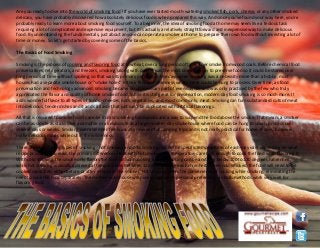
The basics of smoking food
- 1. Are you ready to dive into the world of smoking food? If you have ever tasted mouth-watering smoked fish, pork, cheese, or any other smoked delicacy, you have probably discovered how absolutely delicious food is when prepared this way. And since you've found your way here, you're probably ready to learn more about smoking food yourself. To a beginner, the idea of smoking food at home may seem like a tedious task requiring a lot of complicated and expensive equipment, but it is actually a relatively straightforward and inexpensive way to make delicious food. By understanding the fundamentals, just about anyone can operate a smoker at home to prepare their own food without investing a lot of time or money. So let's get started by covering some of the basics. The Basics of Food Smoking Smoking is the process of cooking and flavoring food at low heat, over a long period of time, over smoke from wood coals. Before chemical food preservatives, refrigerators, and freezers, smoking (along with curing) was the most common way to preserve food so it could be stored over long periods of time without spoiling, so that was its primary purpose. In the days when smoking was a necessity more than a hobby, most houses had a separate smokehouse or "smoke holes" in their fireplace chimneys where meat could be hung to process. Over time, as food preservation and technology advanced, smoking became an unnecessary part of everyday life and was only practiced by the few who truly appreciated the flavor and quality of home smoked food. While it is still great for preservation, modern day food smoking is so much more. It adds wonderful flavor to all types of foods - cheeses, nuts, vegetables, and, most commonly, meat. Smoking can turn substandard cuts of meat into delicious, tender dishes and it adds a flavor that just can't be duplicated with artificial flavorings. All that is required to smoke food is smoke from smoldering hardwoods and a way to suspend the food above the smoke. That means a smoker can be as simple as sticks over a campfire or as elaborate as a large modern-day smokehouse where food can be hung to slowly process over several days or weeks. Smoking over and open fire is usually reserved for camping trips and is not really practical for home. It does, however, make delicious meals while out in the wilderness. There are two primary types of smoking - hot smoking and cold smoking. While the specific temperatures of each may vary depending on what recipe or source you read, the primary difference is that with hot smoking the temperatures are high enough to cook the food while flavoring it. With cold smoking, the smoke only flavors the food without cooking it. Cold smoking can be anything below 100 to 120 degrees Fahrenheit, while hot smoking is usually achieved at temperatures between 120 and 200 degrees Fahrenheit. When cold smoked, the food will need to be cooked separately either before or after it is put in the smoker. Hot smoking offers the convenience of cooking while smoking, eliminating the need to cook the food separately. The method you choose will purely depend on personal preference, as both methods work very well for flavoring food. www.gourmetrecipe.com
